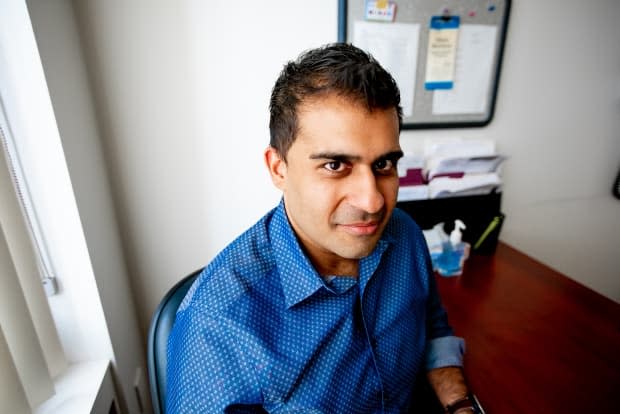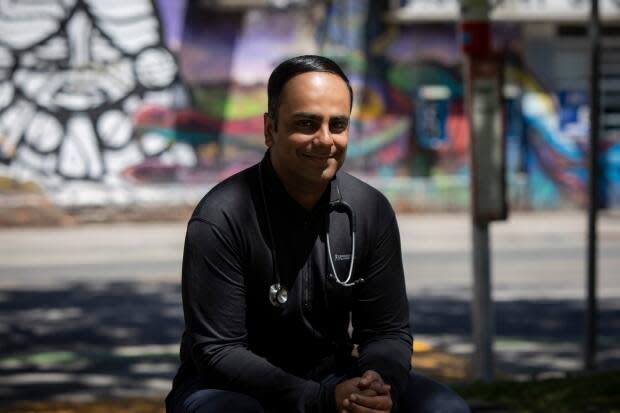COVID-19 variants spreading faster in GTA areas with more low-income residents, essential workers: study

More contagious and deadly variants of the virus behind COVID-19 are disproportionately affecting Toronto-area neighbourhoods with the most essential workers and lowest income levels, new research suggests.
A preprint published on Friday in medRxiv — an online portal for research that is so far unpublished and not yet peer-reviewed — looks at per-capita rates of COVID-19 cases, both overall and those confirmed to be variants, between early February and mid-March in various neighbourhoods of both Toronto and Peel.
During the study period, variant cases emerged faster in groups with the lowest income levels and most essential workers, the research team found.
"As we keep talking about a third wave, it's pretty clear in that data where that third wave is," said author Dr. Zain Chagla, an infectious disease specialist and researcher with McMaster University in Hamilton, Ont.
The analysis broke down the rates of essential work, and the typical amount of income in different areas, into three levels.
It showed the growth rate of variants was nearly 44 per cent in groups with the lowest income level, double the roughly 22 per cent growth seen in the highest income level.
The finding regarding essential workers was similar, with a growth rate of more than 50 per cent in areas with the highest levels of essential workers compared to roughly 18 per cent in the lowest level.
"This population was at high risk," Chagla said. "The same data has been shown prior to the emergence of variants."
But those variants add a new dimension to that risk, with an upcoming Ontario COVID-19 Science Advisory Table briefing expected to show they're proving capable of causing more serious illness — and are roughly 60 per cent more deadly than the initial strain of SARS-CoV-2.
Those variants now make up more than half the province's cases, and are thought to be primarily B117, the variant first discovered in the United Kingdom.
Study echoes earlier findings
The analysis by Chagla's team echoes concerns earlier on in the pandemic over certain neighbourhoods and regions known for lower-income and essential workers — and typically racialized communities — largely bearing the brunt of infections.
The most racially diverse neighbourhoods in Canada reported COVID-19 mortality rates more than twice as high as those reported in districts that are overwhelmingly white, according to data from Statistics Canada, while City of Toronto data shows people of colour make up an overwhelming majority of cases.
Various postal code regions in hot spots like Toronto's northwest end and Brampton have also routinely been identified as having among the highest number of COVID-19 tests coming back positive, according to data from non-profit health research centre ICES.

Chagla said his research was limited by using only positive, confirmed tests. He said that may not tell the full story of infections, which had to be matched with census data to determine neighbourhood characteristics.
Still, he said, the findings are in line with the trends over the last year.
"Given the ways that the COVID-19 pandemic has impacted low-income and racialized people in our communities — I'm not surprised at all," said Dr. Naheed Dosani, a health justice advocate and palliative care physician who was asked for an outside comment on the research.
"Essential workers have been put at the forefront of serving our communities, from production plants to factories to warehouses, without the protections they need to preserve their health."
600+ cases at one Brampton facility
Chagla noted that the study period was during a lockdown in the region, meaning while most people were out and about less often, essential workers kept working and commuting.
A mid-lockdown outbreak at an Amazon Canada facility in Brampton, for instance, made headlines earlier in March after more than 240 cases were identified in the weeks prior, bringing the total number of cases at the site since October to more than 600 — prompting public health officials to order all the employees to self-isolate for two weeks.

Canadians coping with COVID-19 are entitled to access the federal government's Canada recovery sickness benefit (CRSB), which was designed to make it easier for workers to follow public health advice urging people to stay home if they are sick.
It provides $450 after taxes per week for up to two weeks.
While provincial officials have continually stressed that having a paid sick leave program in place ensures workers who fall ill with COVID-19 have support, Dosani said more needs to be done.
"The reality is that the federal paid sick leave program does not meet the needs of workers who are dealing with the pandemic and need to take single days off for COVID-19 testing," he said. "And payment doesn't come back to people for several months."
Chagla said his latest findings back up what's been talked about throughout the pandemic — that certain communities remain at a higher risk.
"It's inequitable," he said.

